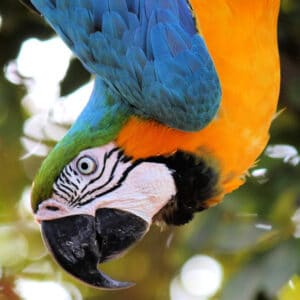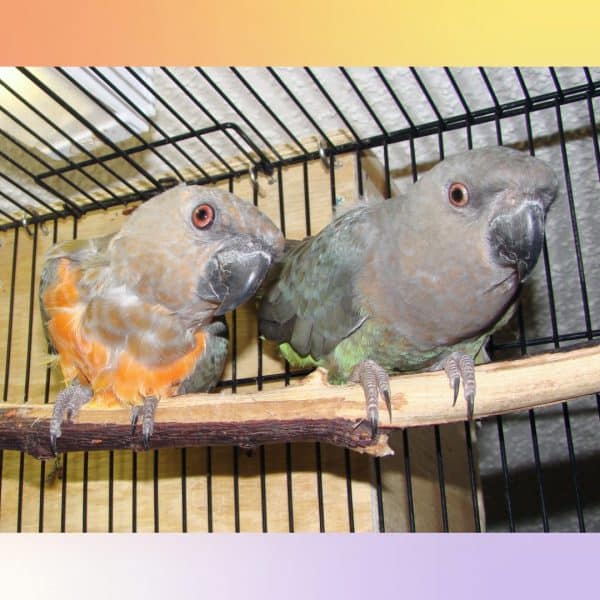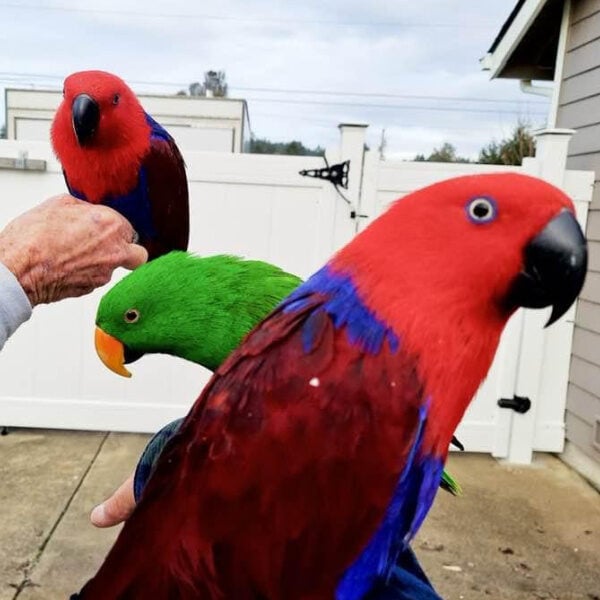
Bird Tips from a Vet
Last Updated on by Mitch Rezman
TIPS FROM THE VET
ON SELECTING AND REARING BABY PARROTS
Louise Bauck, BSc, DVM, MVSc; Rolf C. Hagen Inc.
Rules of thumb:
“Smaller is better”.
Large parrots are a real challenge for us to keep happy as the years go by. A macaw or a moluccan cockatoo need and deserve room for exercise – including flight – and they need lots of attention. Yet these parrots are so big it is very difficult for most of us to give them the busy and active life they should have. Large parrots also make more mess in most cases, and they can make more noise too! The quality of life for a smaller pet parrot such as the delightful senegal or the hilarious caique is usually much higher. Pionus, quakers, and Indian ringnecks are other small parrot species that are also highly recommended. Many other wonderful small parrots are available – ask your pet retailer or avian veterinarian for more information.
“Older is BETTER”.
Hand raised birds bond with anyone, and do not need to be syringe fed by the retailer (or new owner) to stay tame. They need ATTENTION to stay tame. Disease problems, are much more common in unweaned babies – selecting older babies will help you avoid many of these.
“Isolation from other birds”.
Baby handfeds are more susceptible to disease because of their young age. They should not share the same airspace or display areas with adult cockatiels and parakeets (or adult parrots). Keep them away from your own birds when you bring them home from the store. Ask your veterinarian about a quarantine period.
“Heat is good”.
Most of these species are from very hot and humid countries. Ordinary room temperature may be tolerated by a fully-feathered baby, but extra heat in the form of a small 75 watt infrared spotlight will help prevent stress and disease. This is particularly true for baby cockatiels. Just make sure the babies have some way to get out from under the heat lamp if it becomes too hot. Babies that are not fully feathered will need more elaborate heat and humidity controlled enclosures.
“Be a fanatic about cleanliness”.
Remind everyone to wash hands between play and feeding sessions. Use a dishwasher to clean dishes and spoons used for feeding. Provide wet wipes for friends to clean hands with before handling a baby. Never add a new baby into a container or group of unrelated babies, even when of the same species. Use disposable substrates such as recycled newspaper pellets or paper toweling, and change frequently.
“Use a spoon”.
Spoon feeding isn’t just for beginners – it is the perfect weaning instrument as it allows you to spoon down warm, wet Tropican pellets, not just formula. Plus it gives the baby a more natural feeding time. And of course it is much safer – even a novice can usually safely spoon feed most babies.
“Think about your bedding”.
One of the most common causes of death in any handfed baby is ingestion of the bedding. Shavings or corncobs are frequent culprits. Gizzard obstructions are the fatal result. NEVER use corncobs as bedding for a handfed baby parrot or cockatiel. Recycled paper pellets or torn up newspaper, shredded paper, or paper towels are all safer. Even paper pellets (Daily Scoops) should not be eaten, despite their greater margin of safety.
“Don’t clip too much too soon”.
New information suggests that many birds (particularly Amazons) will never learn to fly properly if denied the chance to learn flight as a young bird. Weaning birds should have only a small amount trimmed from their wing feathers until they are actually ascending, then only an inch or two more at a time until level or safely descending flight is achieved. This is called “managed flight”. Of course, the young bird must be protected from hazards around the home. A safe and hygienic exercise area is needed. And greater care will be needed to prevent escapes.
“Have a plan for emergencies”.
Without fail, the most valuable bird in the house will develop a slow crop on Friday night at 8:30 pm. Talk to your avian veterinarian ahead of time about what protocol you should use for slow crops and other common baby problems. Most veterinarians will make sure you have a good nursing set-up (heat and humidity) and may recommend you keep some clear (oral) fluids on hand such as Pedialyte.
Your veterinarian can also go over general preventative medicine strategies with you or your supplier, including disease testing of parent birds, vaccination programs (for example, avian polyomavirus vaccination for baby birds), and pathology (necropsy) protocols. Chicks autolyse quickly must be cultured and/or placed in formalin within a few hours of death (refrigeration may not suffice).
Here are some typical aspects that a veterinarian might wish to know about your breeder. Much of this applies to the store as well:
-
- Veterinary on-site visits to evaluate preventative medicine strategy, records, and nursery hygiene program.
- Equipment suitability including egg incubators (if used), neonatal units, housing units for babies with pin feathers (heat and humidity considerations), weaning units, socialization areas. Substrate selection for neonatal units (i.e. paper towels), baby units (i.e. recycled newspaper pellets), weaning units (i.e. plastic coated grills sized to avoid entrapments). Most neonatal units kept at 92°-94° F; unfeathered chicks 90°-92° F; pin feathered chicks 85°-90° F; and weaning birds 75° F -80° F. Humidity ranges should be above 50% (mandatory for younger birds). Feeding instruments should include syringes of a safe design (no sharp ends or attached tubes). Gavage tubing or crop flushing should only be done by experienced or veterinary personnel.
- Hygiene program including handwashing, feeding instrument handling, fresh food preparation, choice of disinfectants, ventilation, foot traffic and visitor traffic control.
- Disease contact control including separation of babies from different clutches and breeding facilities. Hospitalization or isolation facilities for abnormal babies should be available. No off site birds or adult birds should share air space with the nursery.
- Safety for the young birds including food heating and handling methods, water source, emergency generators/power source.
- Choice of commercial formula(s) for species being raised, freshness, storage program.
- Feeding practices including frequency of feeding, inspection of baby and crop, food temperature, avoiding crop burns, method for starting feeding response, correct and safe delivery of food, degree of crop filling, cleaning of baby.
- Regular weights and record keeping appropriate to the breeder facility, evaluation of these results and chick condition. Evaluation of feces. Emergency medical protocols for “after hours” problems.
- Egg incubation policies; age of babies to be pulled. Socialization program.
- Follow up program with new buyer after sale; information delivered with each baby sold; identification of each baby (microchipping/banding). Age of sale (weaned babies have a higher survival rate and readily accept a new owner if socialized properly).Written guarantee policy.
Louise Bauck, BSc, DVM, MVSc
Rolf C. Hagen, Inc.
Author Profile

Latest entries
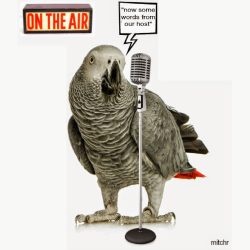 Bird & Parrot CareJune 20, 2025Understanding the Best Way to Use Prevue Pets Mimic Me Voice Trainer
Bird & Parrot CareJune 20, 2025Understanding the Best Way to Use Prevue Pets Mimic Me Voice Trainer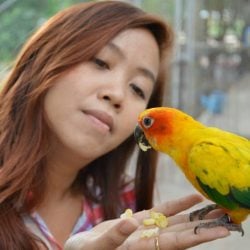 Bird BehaviorJune 6, 2025How Do I Keep My Parrot From Dumping His Food Every Day?
Bird BehaviorJune 6, 2025How Do I Keep My Parrot From Dumping His Food Every Day?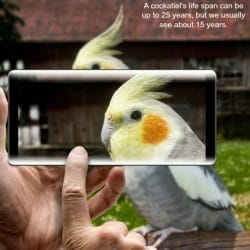 Birds & LightingMay 16, 2025I Am Seeking Clarity About Lighting for My Birds Cage
Birds & LightingMay 16, 2025I Am Seeking Clarity About Lighting for My Birds Cage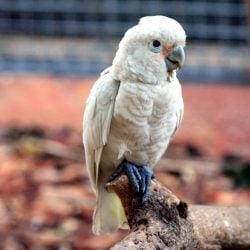 Bird RescueApril 29, 2025How Do We Re-Home a 17 yr Goffin Cockatoo?
Bird RescueApril 29, 2025How Do We Re-Home a 17 yr Goffin Cockatoo?
